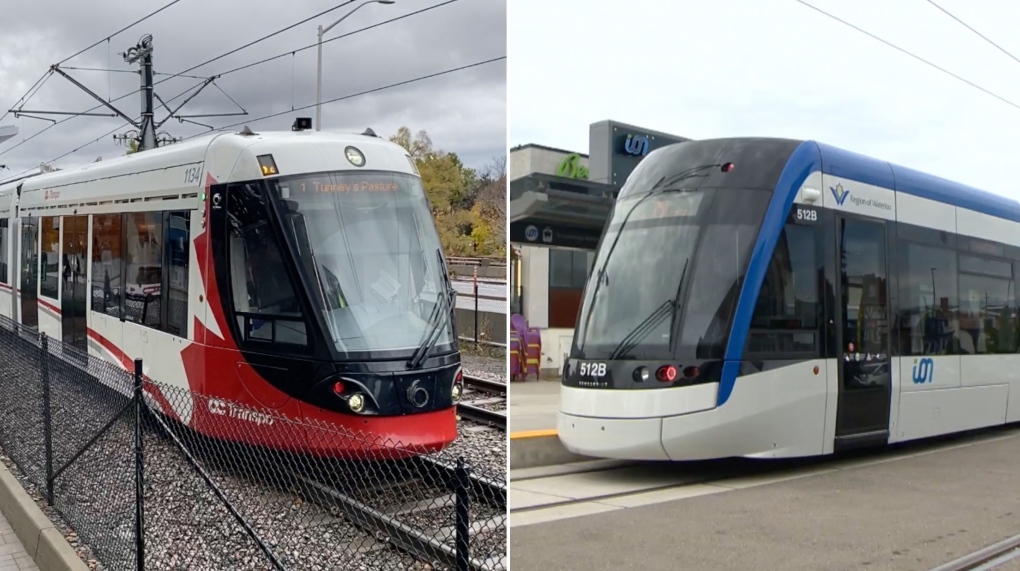Contrasting Ottawa's LRT problems with Kitchener-Waterloo's success story
 Ottawa (left) and Kitchener-Waterloo (right) LRT trains.
Ottawa (left) and Kitchener-Waterloo (right) LRT trains.
It is a tale of two light rail transit systems. In Ottawa, ridership levels have not recovered from the COVID-19 pandemic, but in Kitchener-Waterloo, levels are at record highs.
According to numbers from the city of Ottawa, overall ridership in September was at 72 per cent of pre-pandemic levels, with bus boardings at 85 per cent and O-Train boardings at 49 per cent.
Pat Scrimgeour, director of transit customer systems and planning, says "Downtown-oriented, long distance commuter-oriented are down with so many people working from home either all of the time, or some of the time, so train ridership is a little lower, and bus ridership a little higher than the system average."
The Confederation Line taking a brunt of the low ridership. "The train is serving mostly people who are traveling to, though, and from downtown and downtown is very heavily office employment, and those are the people we understand are working from home."
In the region of Kitchener-Waterloo, their transit service had its busiest month ever in September, with ridership peaking at 2.9 million customer trips. Ridership is up 33 per cent over September 2019, and 44 per cent over 2022. Boarding numbers are also up according to officials. In September, boardings were 43 per cent higher than the average month this year, hitting 3.8 million. An average month for the region is 2.6 million boardings.
The Kitchener-Waterloo LRT launched only three months before Ottawa's.
Colleen James is a councillor with Waterloo region, and says the transit system did take a big hit during the pandemic, but has built back a strong ridership.
"Part of our big success, has to do with the students who we have here. Students are taking transit, cars are too expensive, gas is expensive, and really pushing and building a system that works to get people right through the corridor, which is what we are building, as well."
Unlike Ottawa's problem-plagued system that has included derailments, major outages, and now single-car trains that run more slowly, Kitchener has been relatively problem-free. James says there were growing pains, as well as adjustment for all drivers, but providing public transit options grew their base.
"Making sure there are options and building a route that really goes through our corridor, building development around there as well," James says, "It works, it is dependable. Building trust around the system is a huge part of why people use the system."
Light rail in Kitchener runs along a 19-kilometer track and has 19 stops. Ottawa's Confederation line is 12.5 kiometers and has 13 stops. Scrimgeour says, "They are a different city and their ridership patterns are different. We have historically had very high transit numbers for a city our size and that high ridership has come from a lot of office workers choosing transit."
"Like us, their university based, or school based ridership is likely as high as it was pre-pandemic or perhaps higher."
But Scrimgeour admits that boosting Ottawa's ridership also needs to be about improving the system overall. "We need to be here to move the people who have somewhere to go, in order to do that we need to have a service that is reliable, useful, and comfortable that people can count on. That means we need to have bus service reliability that is better than it has been and it definitely means we need to have train reliability than we have had the past couple of years."
CTVNews.ca Top Stories

Trudeau's 2024: Did the PM become less popular this year?
Justin Trudeau’s numbers have been relatively steady this calendar year, but they've also been at their worst, according to tracking data from CTV News pollster Nik Nanos.
Back on air: John Vennavally-Rao on reclaiming his career while living with cancer
'In February, there was a time when I thought my career as a TV reporter was over,' CTV News reporter and anchor John Vennavally-Rao writes.
The winter solstice is here, the Northern Hemisphere's darkest day
The winter solstice is Saturday, bringing the shortest day and longest night of the year to the Northern Hemisphere — ideal conditions for holiday lights and warm blankets.
What we know about the suspect behind the German Christmas market attack
Germany on Saturday was still in shock and struggling to understand the suspect behind the attack in the city of Magdeburg.
Poilievre writes to GG calling for House recall, confidence vote after Singh declares he's ready to bring Liberals down
Conservative Leader Pierre Poilievre has written to Gov. Gen. Mary Simon, imploring her to 'use your authority to inform the prime minister that he must' recall the House of Commons so a non-confidence vote can be held. This move comes in light of NDP Leader Jagmeet Singh publishing a letter stating his caucus 'will vote to bring this government down' sometime in 2025.
Overheated immigration system needed 'discipline' infusion: minister
An 'overheated' immigration system that admitted record numbers of newcomers to the country has harmed Canada's decades-old consensus on the benefits of immigration, Immigration Minister Marc Miller said, as he reflected on the changes in his department in a year-end interview.
School custodian stages surprise for Kitchener, Ont. students ahead of holiday break
He’s no Elf on the Shelf, but maybe closer to Ward of the Board.
Kelly Clarkson's subtle yet satisfying message to anyone single this Christmas
The singer and daytime-talk show host released a fireside video to accompany her 2021 holiday album, “When Christmas Comes Around” that she dubbed, “When Christmas Comes Around…Again.
Pope Francis reprimands Vatican staff for gossiping in annual Christmas message
Pope Francis told Vatican bureaucrats on Saturday to stop speaking ill of one another, as he once again used his annual Christmas greetings to admonish the backstabbing and gossiping among his closest collaborators.


































